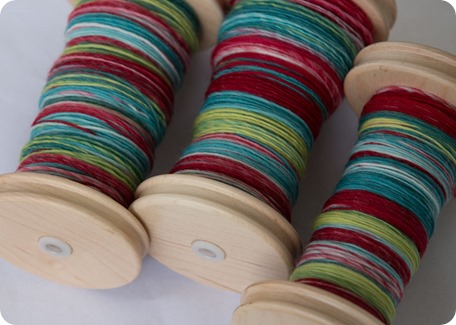After battling technology all weekend, I needed a little bit of a win. This was it. Gorgeous Sweet Georgia Yarns’ July 2014 Fibre Club. Oh, how these colours sang to me. I was able to get a second bump from a friend which meant I had a total of 8 ounces to spin. I spun up the first 4 ounces during Spinzilla (October 2014) and Navajo-plied it since plying counted towards yardage this year. Once finished, I decided to wait to spin the second 4 ounces. I wasn’t totally sure I wanted to Navajo-ply it also.

After a couple of months, I stumbled on this absolute beauty on Ravelry spun by Monika. I have been looking for various traditional 3 ply and Navajo (or chain) plied yarns in people’s handspun stashes on Ravelry. These are my favourite yarns to spin for and I find tremendous inspiration from other people’s results.
So back to the wheel with the second 4 ounces I went!
Fibre :: Sweet Georgia Yarns July 2014 Fibre Club – Superwash Merino + Nylon
Colourway :: Strawberry Season
Finished Yarn :: traditional 3-ply, ~195 yards // Navajo-plied, ~ 220 yards
I love the differences between these two yarns. Of course, the obvious difference is the clean colour repeats of the Navajo-plied yarn versus the barber-poling, or ‘marling’, of the traditional 3-ply.
When singles are Navajo-plied (also called chain plying), the colours are kept together which preserves the colour repeat of the original fibre. This creates a tonal yarn or a variegated yarn. Tonal yarns are analogous colours on the colour wheel (ie. The colours are all next to one another on the colour wheel) and a variegated yarn has individual colour repeats from various sides of the colour wheel, as the photo below shows. This is a great way to keep colours apart that tend to ‘muddy’ – the singles don’t end up ‘touching’ when plied together using a Navajo or chain-ply approach.
A different approach to plying is a ‘traditional’ yarn. My definition of a traditional yarn is singles spun to two or more bobbins and plied together. No bracelet, centre-pull ball, or Navajo or chain plying. It helps me keep it all straight in my mind but again, this is just my definition! All are completely valid ways of plying — I use all of them all the time!
A traditional 3-ply in this case creates a ‘softer’ or more muted yarn. The marling creates flecks of colour that our eyes then visually blend together. Sometimes this can create a grey colour, which is the result of all of the colours on the colour wheel combining with one another, or a secondary colour when two analogous colours ply together (ie. red + blue = purple). Up close, of course, our eyes can see the individual colours, but from afar, really neat colour combinations can result in really beautiful hanks of yarn!
If you look to the back of the above photo, on the left hand side, the marled yarn is really interesting; whereas, in the focused portion of the photo, the individual plies are visible. Isn’t colour theory neat?!
Another obvious difference is the intensity of the colour in the first skein. I already mentioned that marling mutes or softens the colours because they visually mix and blend when we look at the yarn. In the Navajo-plied yarn, however, the red colour of the strawberries, which were Felicia’s inspiration, is preserved completely. The blue of the summer sky is clean and never mixed with the yellow or red due to the repeat that Felicia dyed the fibre. It’s quite genius actually because when one spins for the intention of Navajo-plying, one never has to worry about muddying of colours.
In the marled yarn, however, the colours combine and in some ways … this actually makes me think of a strawberry field way more than the Navajo-plied yarn. In nature, one never comes across a field with perfectly separated colour – instead, you see strawberries partially hidden by bright green leaves. Bright blue summer skies with wisps of white clouds above. And if one is really lucky, rays of yellow sunshine shining on everything.
I think you know that when pushed to chose one, I would chose the marled yarn every time.
But what about you? What do you prefer and why? Do you navigate to one due to the projects you make or is that even a factor? I’d love to hear about your thoughts in the comments!
Happy Spinning :)












Those are both GORGEOUS!! Wow! I couldn’t possibly pick just one :)
I love both, but my answer just depends upon what the end item would be. The Navaho plied yarn would be great for fingerless mitts, but the marled would make a lovely cowl. Even more intriguing is what could you make that required both?
They are so beautiful. I am starting to improve my chain plying and this inspires me. Thanks!
Thank you! Good luck with your chain plying — practice makes perfect?! :)
That is some lovely handspun! If I have a certain pattern in mind, I will choose the ply I think is best suited. But I really like barber-pooling. It´s mostly a spur of the moment thing. I´m such a new spinner, I just do what I feel like. :P